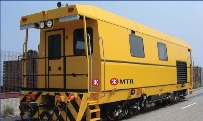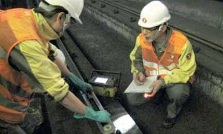
On 2 November 2015, a rail crack with around 1 mm width and a slight offset to the field side were found in a rail section between Lai King Station and Kwai Fong station at Tsuen Wan Line towards Tsuen Wan. They were within the safety tolerances. Nevertheless, trains were required to run at reduced speed on that section of rail in order to further ensure the safe operation. During that period, the Electrical and Mechanical Services Department (EMSD) deployed personnel to comprehend the situation and monitor the urgent repair work. The urgent repair work was completed at around 2 hours later and the train services gradually resumed normal afterwards. The MTRCL also replaced the incident rail after service hours at that night.
Subsequent to this incident, the MTRCL commissioned an expert from the City University of Hong Kong to carry out an independent examination and scientific analysis of the broken rail. The examination and analysis result revealed that the crack was caused by an imperfection in the weld joint during the manufacturing process. The crack did not affect railway safety and was an isolated case. Details are as follows:
The examination and analysis result revealed that the crack occurred at the weld joint of a rail expansion joint (Note 1) which was installed above the structural movement joint (Note 2) in that section. It also found that the crack was initiated at the rail foot and developed into fracture. The weld joint was produced by means of flash butt weld (Note 3) technology. The root cause of the crack was due to an imperfection embedded inside the rail foot. Rail crack incident due to imperfection embedded in flash butt weld joint was rare.
Besides, EMSD engaged a material expert to examine the rail crack and review the investigation result of the MTRCL. The same conclusion was drawn.
According to the information provided by the MTRCL, this flash butt weld joint was produced by the manufacturer of the rail expansion joint in Austria. The manufacturing process complied with the quality control standard of ISO 9001, BS EN14587-1 and BS EN 14587-3 which are adopted by railway industry. The MTRCL had conducted fleet check on the same batch of rail made by the same manufacturer. No similar symptom was found.

EMSD also reviewed the inspection procedures for rail of the MTRCL. For the incident rail section, the MTRCL had carried out visual check every 3 days, ultrasonic test by ultrasonic testing vehicle every 2 weeks, and manual ultrasonic test or dye penetration test at specific locations every 4 to 6 months. Such approach and frequency of inspections were in line with recognised practice of the international railway industry.
Ultrasonic Testing Vehicle →

Nevertheless, in order to further reduce the possibility of the recurrence of similar incident, EMSD had conferred with the MTRCL to work out improvement measures including enhancement of manual test at critical locations of rail (e.g. same type of rail expansion joint at curve similar to the incident section) and adjustment of the weld location of the rail expansion joint for enhancing the support for the weld joint.
Manual Ultrasonic Test →
EMSD ascertained that the MTRCL had adopted appropriate contingency and urgent repair work, replaced the incident rail at that night, and carried out detailed incident investigation subsequently to ensure railway safety. EMSD would continue monitoring the MTRCL to implement the proposed follow-up works.
Note: